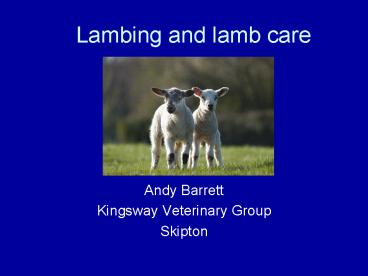Lambing and lamb care - PowerPoint PPT Presentation
1 / 31
Title:
Lambing and lamb care
Description:
Target bcs 2.5. Scan at 70 days. Health issues include: Scab/lice. Feet ... Manipulate head into pelvis, pass rope behind poll and into mouth. Pull legs up. ... – PowerPoint PPT presentation
Number of Views:767
Avg rating:3.0/5.0
Title: Lambing and lamb care
1
Lambing and lamb care
- Andy Barrett
- Kingsway Veterinary Group
- Skipton
2
Outline of course
- Introductions
- Management of pregnant ewes
- Preparing for lambing
- Normal lambings
- Lambing problems
- Practical session
- Caring for lambs
- Caring for ewes after lambing.
3
Flock managementBegins pre-tupping
- EWES Check
- Body condition score
- Teeth
- Feet
- Udders
- Records
- Vaccination status
- TUPS Check
- When do you want to lamb?
- Have you enough?
- Condition score
- Teeth
- Feet
- Genitalia
- Harnesses.
4
Early pregnancy(0 30 days)
- Fertilisation to implantation
- Embryo dependent on hormones
- Very sensitive to stress.
5
Mid pregnancy(30-90 days)
- Placental growth occurs
- Target bcs 2.5
- Scan at 70 days
- Health issues include
- Scab/lice
- Feet
- Liver fluke.
6
Late pregnancy(90-145 days)
- Good feeding essential, because
- Lambs double in size in last month
- Udder development occurs in last fortnight
- Feed according to condition score, litter size,
forage quality, weather - Vaccinate against clostridial disease
- Feet
- Give copper supplement.
7
Problems in late pregnancy
- Abortion
- Vaginal prolapse
- Tremblings
- Twin lamb disease.
8
Abortion
- Isolate aborting sheep and mark them
- Clean and disinfect pen
- Do not mother lambs on
- Speak to your vet
- BE CAREFUL MANY AGENTS ARE ZOONOTIC!
9
Vaginal prolapse
- Fat ewes heavy in lamb
- Treat as quickly as possible
- Clean and replace
- Consult vet if recur
- Mark the sheep.
10
Tremblings
- Hypocalcaemia (low blood calcium)
- Especially horned sheep
- Often in poor condition
- Poor diet
- Often triggered by poor weather or movement
- Treat quickly, 100ml calcium s/c.
11
Twin lamb disease
- Last month of pregnancy
- Thin sheep
- Twins or triplets
- Insufficient feed
- Often triggered by bad weather
- Separate off, blind, tremble, sweet smelling
breath - Treat promptly and hard.
12
Preparing for lambing
- Be ready a week before!
- Staff availability
- Indoors or out?
- Go shopping!
13
Lambing equipment
- Bucket and warm water
- Lubricant
- Gloves
- Lambing loop
- Prolapse retainer
- Marker sprays
- Navel iodine
- Notebook
- Bottle and teats
- Tube feeder
- Colostrum
- Respiratory stimulant
- Thermometer
- Syringes and needles
- Calcium
- Glucose
- Antibiotic injection and spray
- Castration rings.
14
Signs of lambing
- A week to go
- Udder swells and becomes firm
- Abdomen drops
- Vulva becomes soft swollen and reddened.
15
Signs of lambing
- Start of lambing
- Separate from flock, restless
- Stop eating, watch at feeding time
- May star gaze and lick lips
- Dribbles of fluid appear
- Circling and nesting behaviour
- Start to strain
- Water bag appears
- Should lamb in 30 minutes.
16
When to intervene
- If a head appears at vulva
- After 30 minutes of non productive straining
- An hour after water bag bursts if nothing else
appears - If second lamb not born after an hour, or half an
hour of straining.
17
Rules for lambing
- Remember 75 of ewe deaths occur at lambing time!
- Restrain/position ewe well
- Be clean
- Be gentle and patient, you are dealing with
living tissue - Use lots of lubrication
- Lift hindquarters if necessary
- Know when youre beaten! Stop if you make no
progress in 15 minutes.
18
Anatomy
19
Lambing
20
The second lamb
21
Normal presentation
- Both feet and head present (check they are
attached to each other) - Note direction of feet
- A hand in the anus can help.
22
Problem lambingsFoetal dystocia
- Malpresentation
- Mixed up twins/triplets
- Oversized single lambs
- Dead dry/rotten lambs
- Deformed lambs.
23
Leg back
- If there is room cup hand round foot and draw
forward - If no room put head rope on, repel lamb and draw
leg forward.
24
Head back
- Attach ropes to both legs and repel lamb
- Manipulate head into pelvis, pass rope behind
poll and into mouth - Pull legs up.
25
Posterior presentation
- Note direction of feet
- Check joints to be sure
- Dont waste time once the lamb is in the passage.
26
Breech presentation
- Tail present at vulva
- Repel lamb and with cupped hand pull one leg then
the other into the vagina.
27
Problem lambingsMaternal dystocia
- Small or deformed pelvis
- Failure of cervix to dilate (ringwomb)
- Failure of vulva to dilate
- Uterine inertia
- Uterine torsion.
28
After lambing
- Revive the lambs
- Check back inside for another lamb or damage to
the uterus / vagina - Check the udder and teats
- Dip lambs navels
- Pen them up
- Ensure lamb feeds
- Watch for cleansing
- Mark,tail and castrate and turnout.
29
Newborn lamb care
- Colostrum is essential, source of food and
antibodies - 5kg lamb needs 250ml (1/2 pint) in first 4 hours
- Bottle or stomach tube if wont feed
- Have alternative source available
- Ensure lambs are well fed and mothered before
turnout.
30
Problems of young lambs
- Hypothermia
- Imperforate anus
- Intestinal prolapse
- Watery mouth
- Joint ill
- Navel ill
- Fractured ribs/limbs
- Entropion
- Swayback.
31
Aftercare of ewes
- Vaginal prolapse
- Uterine prolapse
- Torn uterus vagina
- Nerve damage
- Retained placenta
- Metritis
- Staggers
- Mastitis.































